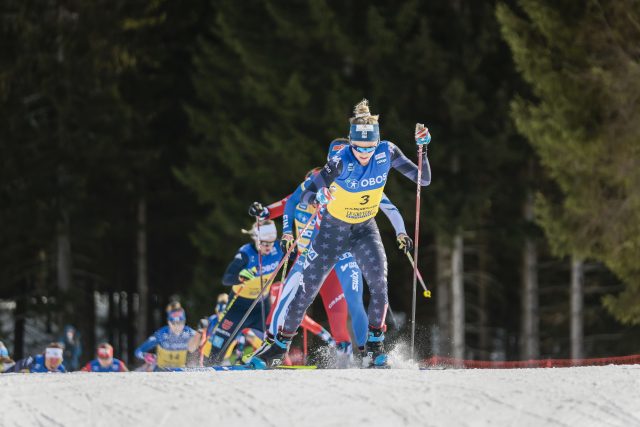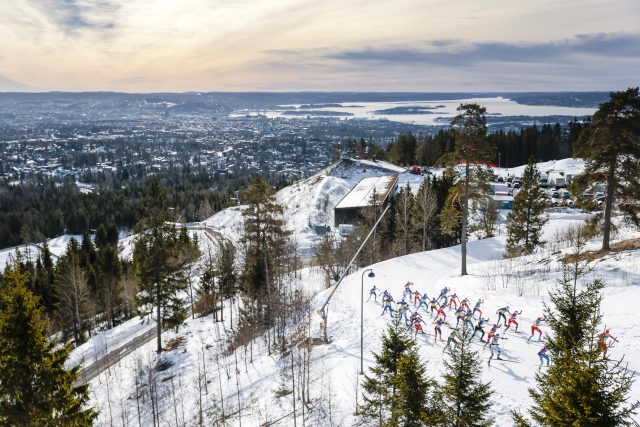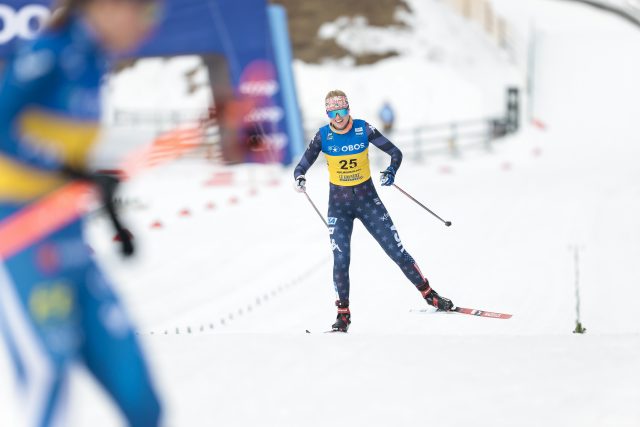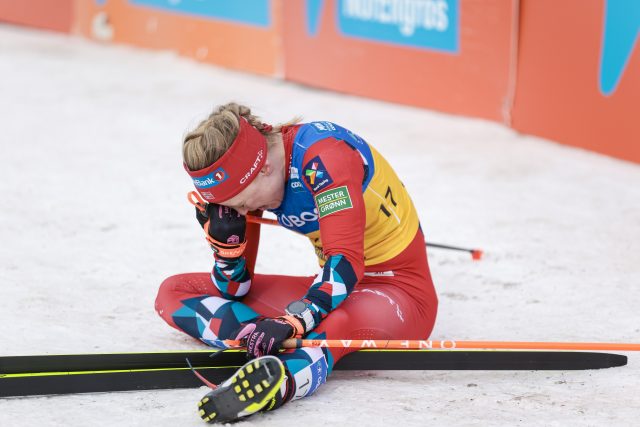 This World Cup coverage is made possible through the generous support of Marty and Kathy Hall and A Hall Mark of Excellence Award. To learn more about A Hall Mark of Excellence Award, or to learn how you can support FasterSkier’s coverage, please contact info@fasterskier.com.
This World Cup coverage is made possible through the generous support of Marty and Kathy Hall and A Hall Mark of Excellence Award. To learn more about A Hall Mark of Excellence Award, or to learn how you can support FasterSkier’s coverage, please contact info@fasterskier.com.

“It’s the right message that we want to send to young girls all over the world: you work just as hard as the guys, you train just as much, you should get to race the exact same races.” Jessie Diggins
History was made today by an entire field of finishers: a daunting distance, a hard-fought battle, equality demonstrated, acknowledgment confirmed. Ragnhild Gloeersen Haga (NOR), Astrid Oeyre Slind (NOR), and Jessie Diggins (USA): theirs was the podium, and the distance, and the accomplishment that will be remembered. That this day has been so long in coming is cause for critical reflection; that this day has finally arrived is cause for celebration. The women’s FIS World Cup field has finally been allowed to race the Holmenkollen 50 k, and our sport is better for it.
That women were capable of racing such distances at such competitive intensities was never in doubt. That women train as hard as men was never up for debate. Still, what has been required is a day when the skiing world—and the media world—not only acknowledges those facts, but actually gets a chance to see them proven. Today, at Holmenkollen, was that day.
“Wow, what a day!” noted Rosie Brennan (USA). “We’re moving forward, and working for equality, and being progressive; that’s something I was willing to fight for today.”
“A race like the 50 k really embodies the spirit of Nordic skiing as a whole,” said American Hailey Swirbul. “It’s about going into the woods, covering a lot of ground as fast as you can, and being supported by a really amazing community. [It was] a beautiful day to make history with some awesome, bad ass women.”
Diggins led all Americans in finishing third—barely outsprinted across this historic finish line by Gloeersen Haga and Slind. Among other Americans, Rosie Brennan earned a hard-fought seventh, Hailey Swirbul 25th, Alayna Sonnesyn 30th. Canada’s Katherine Stewart-Jones finished 16th.
Holmenkollen 50 k
The women’s field is familiar with the challenges of the Holmenkollen course, having raced this course as a 30 k distance many times before. Today’s race, though, involved six laps of this famed course over a distance of fifty kilometers, a distance usually reserved for flatter, less-challenging marathon races. Today’s race wasn’t just longer than normal, it was entirely different.
It was evident in scenes framed by broadcast TV cameras that the pace of the race heated up quickly. The early pace was often driven by lesser-known Norwegians—Margrethe Bergane (former Junior World Champion) and Nora Sannes—who seemed determined to make the race fast and difficult. American skiers made the initial selection with Diggins winning the initial bonus sprint two places ahead of Tiril Udnes Weng, her rival in the race for the season-long Overall World Cup.
The six World Cup sprint bonuses would define much of the action in the early laps—racers knew that there were 90 total points available to any skier who could win all six intermediate sprints (nearly as many points as winning the day’s race, outright). Much was at stake for contenders for both the Overall Crystal Globe and the Distance Globe: Diggins, Weng, and Kerttu Niskanen (FIN) would be locked in that secondary battle the entire day. Diggins won the first bonus sprint (with Weng third). Diggins won the second bonus sprint (Niskanen second, Weng third). It became clear that Diggins was willing to gamble on pursuing the sprint bonuses even at the risk of undoing her chances of winning the day’s race. It was a bold maneuver, and one that paid off in Diggins markedly reducing her points-deficit to Weng in the Overall.
Ambitious young Norwegians—and intermediate sprint opportunities—animated the first half of the race, interrupted briefly by the opportunity taken by most racers to switch to fresh skis at the end of lap three. Diggins skis seemed especially fast, allowing her to flow efficiently into an 11-woman lead group that began forming: Slind (racing in her club suit rather than the familiar Norwegian team suit), Patricija Eiduka (LAT), Eveliina Piipo (FIN), Kerttu Niskanen (FIN), Nora Sannes (NOR), Tiril Udnes Weng (NOR, Margrethe Bergane (NOR), Theresa Stadlober (AUT), Brennan, Diggins, and Gloeersen Haga. Ultimately Piipo, Niskanen, Hagga, Eiduka, and Brennan would fall back, leaving a lead group of six that was mostly paced by Diggins (whose moves were marked closely by Weng).

The lead group came through the stadium at the beginning of the final lap: Bergane, Diggins, Stadlober, Haga, Slind, Sannes, Weng . . . with Weng beginning to dangle as the lead group approached the final bonus sprint. Diggins was second to cross the sprint line for the final set of bonus points, looking around at the field to check her status for the final kilometers. She’d earned 87 World Cup bonus points, and reduced her deficit to season leader, Weng. Her cumulative totals were also enough for her to displace distance leader, Niskanen. Diggins had already accomplished much, but an historic finish line was looming, as well. The distance and the effort had taken their toll:
“By the end I was pretty much cramping everywhere,” Diggins recalled. “The arches of my feet, the inside of my knee, my quad, my hip, my lats, and my triceps. Pretty much all the muscles you use for skiing. I was honestly thrilled to find myself in the sprint-out, fighting for the win . . . it was so awesome to be part of that.”
After two hours and thirteen minutes of intense racing, the race came down to a sprint for the line. Gloeersen Haga outsprinted Slind and Diggins, all of them finishing with half a second of one another. Haga had come back from mid-race deficits to display the sort of form that won her the Olympic gold in the 10 k Freestyle at PyeongChang. It was sweet vindication for a skier who has often been overlooked in recent years . . . and a sweet form of redemption for generations of skiers who have been doubted and overlooked for far too long.

“It was so so cool to finally get to do this race,” said Diggins. “I’ve spoken very passionately about this before; I think it’s the right message that we want to send to young girls all over the world: you work just as hard as the guys, you train just as much, you should get to race the exact same races.”
“First 50 k ever in the books,” said Swirbul. “I am really stoked to be able to check that goal off the list!”
Women’s Holmenkollen 50 k Freestyle Mass Start RESULTS

John Teaford
John Teaford—the Managing Editor of FasterSkier — has been the coach of Olympians, World Champions, and World Record Holders in six sports: Nordic skiing, speedskating, road cycling, track cycling, mountain biking, triathlon. In his long career as a writer/filmmaker, he spent many seasons as Director of Warren Miller’s annual feature film, and Producer of adventure documentary films for Discovery, ESPN, Disney, National Geographic, and NBC Sports.



